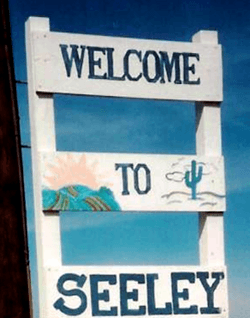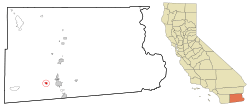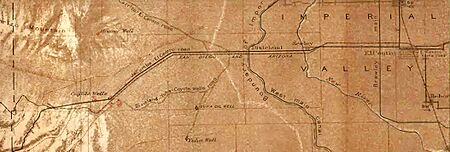Seeley, California facts for kids
Quick facts for kids
Seeley
|
|
|---|---|

Seeley's welcome sign
|
|

Location in Imperial County and the state of California
|
|
| Country | United States |
| State | California |
| County | Imperial |
| Area | |
| • Total | 1.242 sq mi (3.218 km2) |
| • Land | 1.219 sq mi (3.157 km2) |
| • Water | 0.023 sq mi (0.061 km2) 1.9% |
| Elevation | -36 ft (-11 m) |
| Population
(2020)
|
|
| • Total | 1,729 |
| • Density | 1,353.3/sq mi (507.5/km2) |
| Time zone | UTC-8 (Pacific (PST)) |
| • Summer (DST) | UTC-7 (PDT) |
| ZIP code |
92273
|
| Area codes | 442/760 |
| FIPS code | 06-70798 |
| GNIS feature IDs | 1661418, 2409303 |
Seeley is a census-designated place (CDP) in Imperial County, California. Seeley is located 7.5 miles (12 km) west of El Centro. The population was 1,823 at the 2010 census, up from 1,624 in 2000. It is part of the El Centro Metropolitan Area.
Contents
History
The first post office at Seeley was opened in 1909. The name honors Henry Seeley, an early developer of Imperial County.
Seeley is one of the oldest established communities in Imperial County, tracing its history back to the early years of the 20th century. It was originally established as a stage stop on the shores of the now dead Blue Lake.
NAF El Centro, the winter home of the Blue Angels, was built adjacent to Seeley in 1946. In 1964, Interstate 8 was run a mile south of Seeley, marking the lowest elevation on the Interstate Highway System at -52 feet.
Geography
Bordered on the west by the New River, Seeley sits astride the Imperial Fault and above what was once the basin of the "Blue Lake". Like much of the Imperial Valley, Seeley lies entirely below sea level.
According to the United States Census Bureau, the CDP has a total area of 1.2 square miles (3.1 km2), of which 1.2 square miles (3.1 km2) is land and 0.02 square miles (0.052 km2) (1.9%) is water.
Climate
This area has a large amount of sunshine year-round due to its stable descending air and high pressure. According to the Köppen Climate Classification system, Seeley has a desert climate, abbreviated "Bwh" on climate maps.
Demographics
2010
The 2010 United States Census reported that Seeley had a population of 1,823. The population density was 1,399.9 inhabitants per square mile (540.5/km2). The racial makeup of Seeley was 746 (42.9%) White, 19 (1.1%) African American, 7 (0.4%) Native American, 21 (1.2%) Asian, 2 (0.1%) Pacific Islander, 793 (45.6%) from other races, and 151 (8.7%) from two or more races. Hispanic or Latino of any race were 1,489 persons (85.6%).
The Census reported that 1,823 people (100% of the population) lived in households, 0 (0%) lived in non-institutionalized group quarters, and 0 (0%) were institutionalized.
There were 493 households, out of which 276 (56.0%) had children under the age of 18 living in them, 268 (54.4%) were opposite-sex married couples living together, 114 (23.1%) had a female householder with no husband present, 28 (5.7%) had a male householder with no wife present. There were 40 (8.1%) unmarried opposite-sex partnerships, and 2 (0.4%) same-sex married couples or partnerships. 66 households (13.4%) were made up of individuals, and 27 (5.5%) had someone living alone who was 65 years of age or older. The average household size was 3.53. There were 410 families (83.2% of all households); the average family size was 3.83.
The population was spread out, with 577 people (33.2%) under the age of 18, 195 people (11.2%) aged 18 to 24, 421 people (24.2%) aged 25 to 44, 373 people (21.4%) aged 45 to 64, and 173 people (9.9%) who were 65 years of age or older. The median age was 28.5 years. For every 100 females, there were 95.4 males. For every 100 females age 18 and over, there were 85.3 males.
There were 556 housing units at an average density of 447.6 per square mile (172.8/km2), of which 49e were occupied, of which 246 (49.9%) were owner-occupied, and 247 (50.1%) were occupied by renters. The homeowner vacancy rate was 5.3%; the rental vacancy rate was 10.5%. 892 people (51.3% of the population) lived in owner-occupied housing units and 847 people (48.7%) lived in rental housing units.
2000
As of the census of 2000, there were 1,624 people, 438 households, and 382 families residing in the CDP. The population density was 1,346.3 inhabitants per square mile (519.8/km2). There were 460 housing units at an average density of 381.3 per square mile (147.2/km2). The racial makeup of the CDP was 54.7% White, 0.7% Black or African American, 1.0% Native American, 2.3% Asian, 0.1% Pacific Islander, 35.9% from other races, and 5.2% from two or more races. 81.5% of the population were Hispanic or Latino of any race.
There were 438 households, out of which 54.8% had children under the age of 18 living with them, 66.4% were married couples living together, 16.4% had a female householder with no husband present, and 12.6% were non-families. 9.8% of all households were made up of individuals, and 4.8% had someone living alone who was 65 years of age or older. The average household size was 3.7 and the average family size was 4.0.
In the CDP, the population was spread out, with 38.2% under the age of 18, 8.7% from 18 to 24, 28.8% from 25 to 44, 17.1% from 45 to 64, and 7.1% who were 65 years of age or older. The median age was 27 years. For every 100 females, there were 96.6 males. For every 100 females age 18 and over, there were 88.2 males.
The median income for a household in the CDP was $31,058, and the median income for a family was $31,667. Males had a median income of $28,654 versus $20,625 for females. The per capita income for the CDP was $9,539. About 22.2% of families and 26.3% of the population were below the poverty line, including 36.0% of those under age 18 and 18.0% of those age 65 or over.
Infrastructure
Seeley County Water District, a special district, provides water and sewer service to Seeley.
California Historical Landmark
Near Seeley is California Historical Landmark number 1008, Yuha Well. Juan Bautista de Anza visited the well on March 8, 1774.
The California Historical Landmark marker reads:
NO. 1008 YUHA WELL - Known as Santa Rosa de Las Lajas (Flat Rocks), this site was used on March 8, 1774 by the Anza Exploring Expedition, opening the land route from Sonora, Mexico, to Alta California. On December 11 to 15, 1775, the three divisions of Anza's colonizing expedition used this first good watering spot beyond the Colorado River on the way from Sonora to San Francisco.
See also
 In Spanish: Seeley (California) para niños
In Spanish: Seeley (California) para niños



